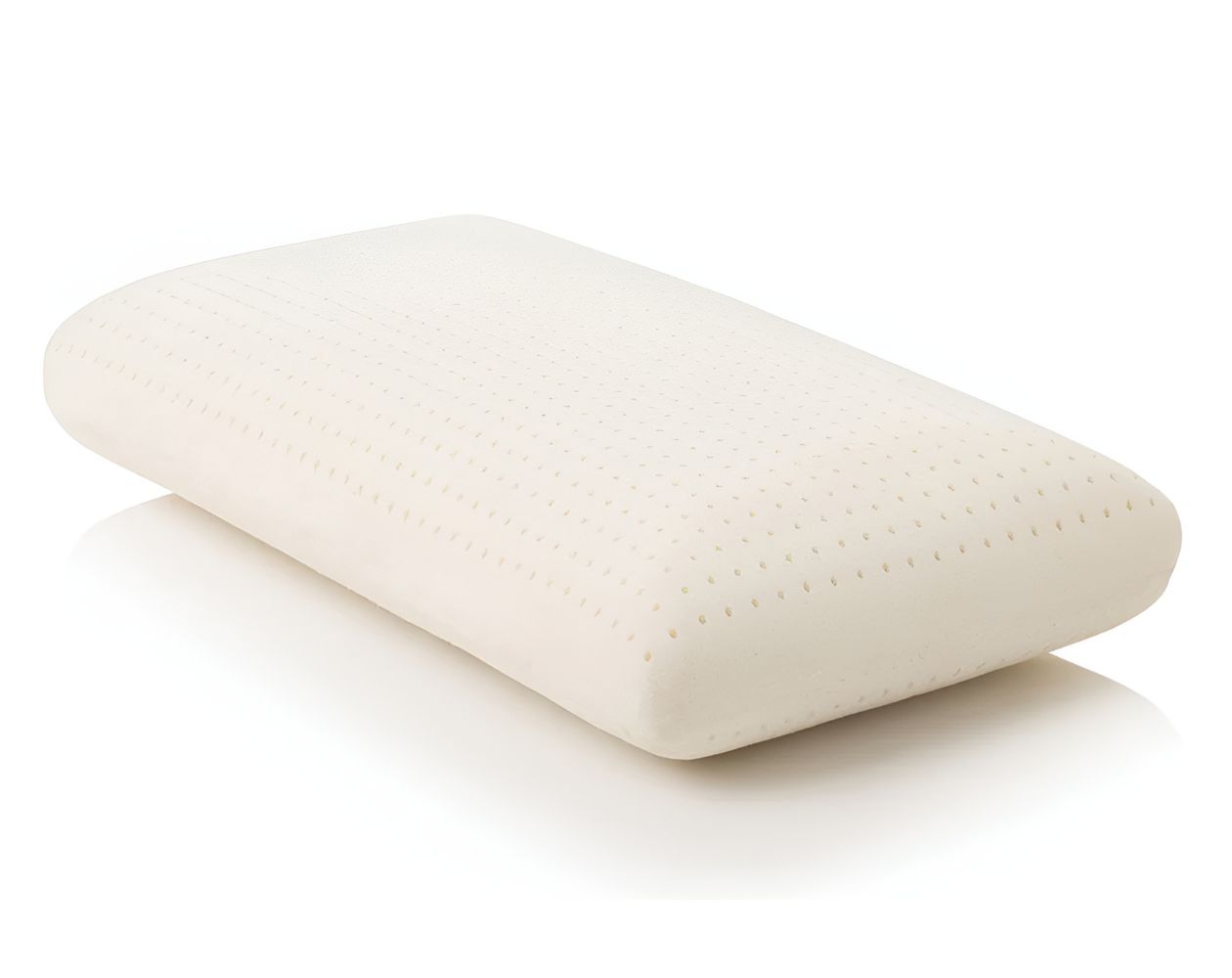Latex foam pillows have become popular as consumers seek sustainable, comfortable, and health-conscious sleep solutions.
Unlike traditional pillows filled with synthetic fibers or down, latex foam pillows offer a unique blend of support, breathability, and eco-friendliness.
In this article, you’ll explore the science, benefits, and practical considerations of choosing a latex foam pillow, providing steps to help you make an informed decision for better sleep.
What is a Latex Foam Pillow?
A latex foam pillow is crafted from latex, a material derived from the sap of rubber trees or synthesized through chemical processes.
Two primary types of latex are used in pillows: natural (derived from rubber tree sap) and synthetic (made from petroleum-based compounds).
Natural latex is often preferred for its sustainability and hypoallergenic properties, while synthetic latex can be more affordable but may lack the same durability.
Latex foam pillows have two manufacturing methods: Dunlop or Talalay. The Dunlop process produces a more dense and firmer pillow, suitable for people with forceful requirements.
The Talalay process, which entails extra procedures such as vacuuming and freezing, produces a lighter, fluffier, and softer-feeling pillow. Both can maintain latex’s main advantages: resilience, breathability, and resistance to dust mites and mold.
Why Choose a Latex Foam Pillow?
Latex foam pillows are distinguished by their comfort and support balance. So, here is what you can learn about their main advantages, corroborated with the recent findings in the industry:
- Superior Support and Spinal Alignment
Latex foam pillows do not lose shape and, as such, offer uniform support even at the end of the night.
The natural elasticity of latex supports the head and neck. It ensures that different sleeping positions, such as those supporting side, back, and stomach sleepers, support the neutral curvature of the spine.
- Breathability and Temperature Regulation
Latex foam pillows feature an open-cell structure that promotes airflow and prevents heat buildup. Unlike memory foam, which can trap heat, latex stays cool, making it ideal for hot sleepers.
- Hypoallergenic and Antimicrobial Properties
Latex is naturally resistant to dust mites, mold, and bacteria, making it ideal for allergy sufferers.
- Durability and Longevity
Traditional pillows come with a lifespan of 2-3 years, unlike the high-quality latex foam pillows, which last 5-10 years.
Natural latex is resistant to sag and deformation and is a good deal at a moderate price.
- Eco-Friendly and Sustainable
Natural latex can be degraded and obtained by using lipophilic rubber trees. Organizations such as the Global Organic Latex Standard (GOLS) certify brands that guarantee environment-friendly processes through sustainable harvesting.
On the contrary, synthetic latex and traditional foam pillows add to landfills.
Technical Insights: How Latex Foam Pillows Are Made
The production of latex foam pillows makes them unique, and understanding the production process explains the properties. This is what it breaks down to:
- Harvesting: Raw latex starts with the rubber tree’s sap collection, which requires 6-8 hours per tree. The sap is prepared with curing agents and made into a foamy substance.
- Dunlop Process: The latex is formed in moulds, baking, and washing. This forms a denser, less uniform foam suitable for firm pillows.
- Talalay Process: Post-pour, the latex is vacuum-packed, frozen, and baked, giving a less firm and more consistent foam. This makes it more breathable because the cost of production is raised.
- Shaping: The pillows are conformed into contoured, shredded, or solid shapes. Latex can be shredded to allow the ability to adjust to higher loft and contoured shapes to accommodate the preferences of certain sleep positions.
Quality control must be effected. The latex is certified by GOLS and OEKO-TEX, which guarantee that no harmful chemicals are present (such as volatile organic compounds (VOCs).
To ensure that the latex foam pillow bought is of quality and is not mixed with any other, always ensure that such certifications are present on a purchased pillow.
How to Choose the Right Latex Foam Pillow
When choosing the best latex foam pillow, it is essential to consider your sleeping patterns, health requirements, and your tastes and preferences. Steps to be taken include:
- Determine Your Sleep Position
- Side Sleepers: A high-loft(5-7 inches) latex foam pillow will fill the crevice between the shoulder and head, keeping the spine straight.
- Back Sleepers: The medium-loft (4-6 inches) pillow would make your neck maintain its natural curve.
- Stomach Sleepers: If you sleep on your stomach, choose a low-loft (3 inches to 4 inches) or shredded latex pillow to avoid straining the neck.
- Assess Firmness and Type
- The firm pillows (Dunlop) are better suited to persons who require sturdy support, such as side sleepers with neck problems.
- Talalay can be used to produce softer pillows that would suit back or stomach sleepers who are looking to feel something plush.
- Shredded latex pillows give the comfort of adjusting the fill to the individual.
- Check Certifications
Seek after GOLS or OEKO-TEX certifications to ensure they are eco-friendly and safe. It is essential to avoid pillows with unclear statements suggesting that they are made of 100 percent latex, as those might be synthetic combinations.
- Test Breathability and Cover Material
Opt for a pillow with an organically grown cotton or bamboo covering that offers cooling. Brands such as Saatva or Avocado also have machine-washable arrangements.
- Consider Budget and Warranty
Latex foam pillows cost between 50 and 150 dollars. There are also longer warranties (5 years to 1 decade) and trial durations (30 nights to 1 century), sometimes with higher-priced items.
Companies such as PlushBeds and Nest Bedding offer risk-free trials to test the pillow before you leave home.
- Read Verified Reviews
Go on unbiased reviews such as Sleep Foundation or Consumer Reports. According to a 2020 Wirecutter report, Saatva latex foam pillows and Latex for Less pillows were top performers when rated against durability and comfort.
FAQs About Latex Foam Pillows
1. Are latex foam pillows good for neck pain?
Yes, latex foam pillows provide excellent cervical support, reducing neck pain by maintaining spinal alignment. Choose a medium-to-firm pillow suited to your sleep position.
2. How long do latex foam pillows last?
High-quality latex foam pillows last 5–10 years, depending on care and usage. For maximum durability, look for GOLS-certified pillows.
3. Can latex foam pillows be washed?
Most latex foam pillows are not machine-washable. They can be spot-cleaned with mild soap and water, and they can be kept clean by using a pillow protector.
4. Are latex foam pillows eco-friendly?
Natural latex foam pillows are eco-friendly, biodegradable, and sourced from renewable rubber trees. Look for GOLS certification to ensure sustainability.
5. What’s the difference between Dunlop and Talalay latex foam pillows?
Dunlop latex is denser and firmer, which is ideal for firm support. Talalay latex is softer and airier, offering a plusher feel. Both are durable and hypoallergenic.





